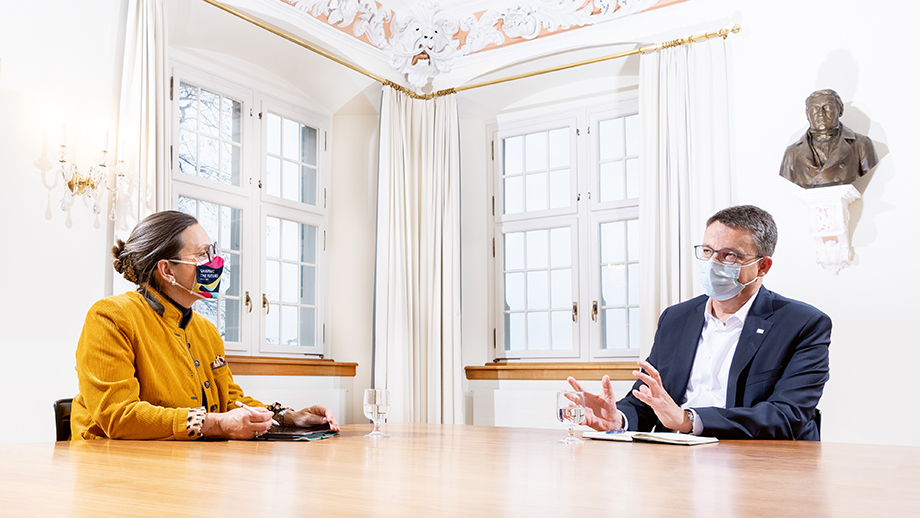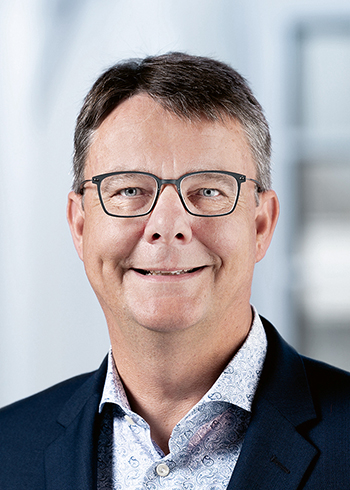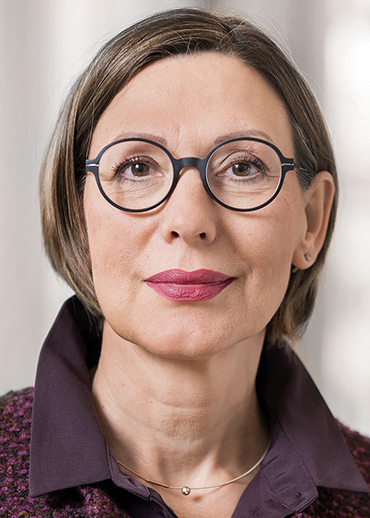“We don’t want to see a coronavirus generation”
In this interview, UZH President Michael Schaepman and Deputy President Gabriele Siegert state unequivocally that the university is doing everything in its power to enable students to complete the Fall Semester as normal. The university is well set up for digital teaching in technological terms; on the personnel side, however, it’s reaching its limits.
Interview*: Stefan Stöcklin; English translation by Michael Craig
Gabriele Siegert, until the end of July you were interim president and charged with steering UZH through the first wave of the pandemic. How did you experience this time? What was the most important lesson from the crisis situation?
Gabriele Siegert: The first wave was very intense for everyone involved because we constantly had to adapt to new circumstances. Looking back, the most impressive thing for me is how quickly we managed to switch teaching to online formats and adapt our research activities. I sensed a strong feeling of belonging, which made me optimistic in terms of the university as a whole.
How did you master such a strenuous situation? For months you had to work weekends.
Siegert: The Executive Board almost always works at the weekend, even under normal circumstances. And especially in a crisis. The situation was stressful, and only manageable because everyone helped and supported me.
Michael Schaepman, we’re now in the second wave, with the situation very dynamic and changing from day to day. How are you dealing with the challenge?
Michael Schaepman: The situation briefly let up a bit over the summer, and the university is very well placed. The second wave is again a challenge for us, but thanks to our experience in the spring, our processes are well rehearsed and work well. Naturally there’s a heavy workload, but it’s gotten heavier for all members of UZH, not just me.
What concerns you most as president?
Schaepman: Right now our biggest concern is making as many courses as possible available to students in a form that enables them to complete the semester as normal. At the moment, what we’re offering is a reduced, hybrid form of teaching where courses can only be held on site in exceptional cases, for example lab courses. So there are many students who have had to switch from classroom to digital teaching a second time, as they did in the Spring Semester. That raises questions around the compatibility of studies, which is something we want to assure whatever happens.
What are the most important lessons from the first wave of the pandemic?
Siegert: Thanks to a tremendous joint effort, we succeeded in making the transition to online formats. As regards digital teaching and learning formats, we have to give some thought as to how we can reduce the effort involved to a more manageable level in the future. Another insight has to do with the different viewpoints of different areas of the university on the pandemic. In other words, we have to reconcile the views of Central Services and research and teaching even more closely and adapt our crisis management.
That sounds a bit abstract. What does it mean in concrete terms?
Siegert: For example, from the perspective of the crisis team and Central Services, it makes sense to close certain rooms; from the point of view of students who rely on workspaces, it’s often not clear why this is done. Communicating about these things is challenging. If I decide on changes in teaching, I have to address some 26,000 students on hundreds of different programs. I have to inform them and reassure them that they’ll be able to complete the semester as normal, even though the actual details have to come from the faculties and departments. That’s different from the messages you send to Central Services employees about working from home. Here the arrangements are more uniform, even though the actual form they take is also the responsibility of the departments.
What do you consider the most important lessons from the first wave?
Schaepman: For one thing, I was surprised by the creative solutions sparked by the crisis. I’ve never been to so many digital cafés as I have recently. Another striking thing for me was the great solidarity among students. People from a whole range of different cultures helped each other, for example to meet the requirements of the authorities and the Executive Board. As for research, new networks sprung up, for example with ETH and USZ. People working in coronavirus research teamed up with people they hardly knew before.
At the moment, no one knows when the situation will return to normal. Can the quality of studies be maintained if digital teaching has to go on for longer?
Siegert: Yes, we can continue to assure the quality of teaching, but it requires an awful lot of effort to make sure interactions work properly. The interactive component is a challenge for all teaching formats, but particularly for online formats. It requires additional effort. In time, the additional effort involved will decrease, but at the moment it requires a lot of extra work.
Schaepman: I’d like to add that there might be parts of the curriculum that we can’t simply replace with digital teaching formats, for example vocational courses that involve practical training or internships. At the moment, those studying medicine can’t practice with patients because hospitals, for understandable reasons, can’t allow students on their premises. In some cases we’ve already shifted courses of this sort from the Spring to the Fall Semester. Now we’re going to have to postpone them yet again.
There’s already talk of a coronavirus generation.
Schaepman: We’re determined to maintain quality. We want to avoid a coronavirus generation with the reputation of being less capable. We see that students studying from home are making great efforts to keep their quality up. They’re showing an extremely high degree of personal responsibility. After all, students can’t afford to have worse opportunities on the employment market. But we currently don’t know precisely whether they learn more or less effectively at home than at university. The good news is that students get to acquire new skills when it comes to using digital media. These will be in demand in the future.
Siegert: This semester we’re carrying out comprehensive course evaluations among students and instructors across the university. As soon as we have these representative findings, we’ll be able to see what’s been working and what’s not been working so well.
How are you planning the coming semesters?
Siegert: This situation calls for agility and flexibility. We’ve communicated the requirement that teaching in the 2021 Spring Semester should be planned the same way as the current semester; in other words, plans should be made for both classroom and online teaching, so that we can switch rapidly depending on the situation.
Where’s the pandemic having the greatest impact on UZH?
Schaepman: Different areas of teaching and research have been affected by the pandemic. But from my point of view, the most serious effect is the way it’s impeding serendipity, in other words chance observations and discoveries. The academic world thrives on unplanned, surprising observations and discussions, whether they’re in lab experiments, in cafeterias or in the office. It’s more or less impossible to replace this spontaneous exchange with digital means, and it’s something that affects all the faculties in equal measure.
Siegert: Your remark about the lack of chance encounters and spontaneous exchange is important. This is something we’re very aware of at the moment as a university. We need informal encounters and discussions.
What does this situation mean for junior researchers?
Schaepman: After the first lockdown, we introduced emergency measures, and tried to cushion delays in research and assure equal opportunity by way of extra funding and extensions. But what people are unable to do in this pandemic situation is assess and position themselves in comparison with their peers. This is something that usually happens at conferences and meetings. Given that interactions of this sort run via informal and chance contacts, they’re hard to replicate on digital formats. The fact that there are no conferences is a big problem, although I don’t know for sure how grave the consequences will be.
It’s not just students, instructors and researchers who are affected; staff at Central Services are too. What do you have to say about their situation?
Schaepman: The workload has increased for people in many areas of Central Services, for example those supporting the digitalization of lectures or maintaining the premises during the lockdown. The fact that it’s been possible to keep the university operating is thanks in large part to the efforts of people in these units.
Is UZH sufficiently prepared in the event that the pandemic goes on for even longer?
Schaepman: I’d make a distinction between technological and personnel resources. On the technical side, we’re very well placed, and until now haven’t had any major incidents or failures. But on the personnel side, we’re reaching our limits. Instructors are having to put in considerable extra work.
Siegert: Digitalized teaching doesn’t mean less work. It requires at least as much work, and above all additional skills. You first have to learn how to host a course via Zoom, set up work groups, and hold separate breakout sessions.
Do you thing that experience with the pandemic will change teaching in the long term, even after the current crisis is over?
Siegert: I can imagine that courses will be designed on a more modular basis in the future. By this I mean short podcasts in combination with interactive classroom courses. That would require a new type of teaching set-up.
Schaepman: I also see increased digitalization as an opportunity to develop new, flexible forms of teaching. It’ll be interesting to see whether we’re able to get the material across well enough with digital teaching, or maybe even better than we did previously. My hypothesis is that the authenticity of the instructor has a much greater influence on learning success than the form of teaching, in other words whether the material is offered in digital or analog form. But it’s much harder to get authenticity across digitally than face to face!
Do good, authentic instructors come across just as well digitally as in the lecture hall?
Siegert: Some instructors are better suited to face-to-face teaching; others are better suited to online formats. It may well be that those who make the best impression online aren’t the same ones who do so in the physical classroom.
What are your long-term expectations in terms of working and studying from home? Will we increasingly work from home even after the pandemic?
Schaepman: I can see it happening less among students. Many live in shared accommodation and have little privacy – quite apart from the fact that internet bandwidth is likely to be a problem in some places. The situation is similar for staff. Having your own office at home is a luxury. But in the future, working from home will help create more flexible workplaces. More and more people will spend part of their time working at home and part working at the office. But the stress of working at home if you have children shouldn’t be underestimated.
Siegert: Naturally you need the right technical infrastructure. Back in spring we noticed that not all staff have access to a laptop so that they can switch between the office and home.
The coronavirus pandemic is striking at the heart of science and higher education. Mobility and exchange are limited. How will the pandemic change academia in the long term?
Siegert: You should also see the positives. There used to be talk of replacing conferences with online formats and reducing air travel in the name of sustainability. Now that’s become a reality, and I’m convinced that some parts of it are here to stay. As researchers, we’ll have to weigh up the pros and cons of physical and digital presence more carefully. But physical conferences will also take place in the future. They’re a necessary part of networking, chance encounters and contact with people.
Schaepman: I also think that in the future we’ll increasingly make choices about what we can pursue digitally and when it’s more fruitful to be at a conference in person. For me that’s a gain, because we’ll be in a better position to set our own priorities and decide what networks we want to be present in, what’s important, and what’s not. A more flexible conference scene is no threat to the scientific community, but certainly helps in terms of sustainability.
*The interview took place at the beginning of November.


